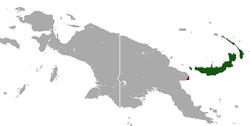Top Qs
Timeline
Chat
Perspective
Bismarck masked flying fox
Species of bat From Wikipedia, the free encyclopedia
Remove ads
The Bismarck masked flying fox (Pteropus capistratus) is a species of flying fox in the family Pteropodidae found in Papua New Guinea and named after the Bismarck Archipelago. It was once considered a subspecies of Pteropus temminckii before being reassessed in 2001. This species has two subspecies, P. c. capistratus and P. c. ennisae.[2] The IUCN classified it as Near Threatened in 2009, noting that the rate of decline is almost high enough to reclassify the species as Vulnerable.[1]
Remove ads
Taxonomy
The Bismarck masked flying fox was described as a new species in 1867 by German naturalist Wilhelm Peters.[3] Prior to 1995, the Bismarck masked flying fox was largely considered a subspecies of the Temminck's flying fox (Pteropus temminckii).[4]
Description
Its forearm length is 109–118 mm (4.3–4.6 in).[5]
Biology and ecology
It is one of the rare species of mammals in which the males can lactate.[6] It is generally solitary, though males and females may roost together in pairs.[7]: 6
Range and habitat
The Bismarck masked flying fox is endemic to Papua New Guinea where it has been documented at a range of elevations from 0–1,200 m (0–3,937 ft) above sea level.[1]
Conservation
As of 2021, it is evaluated as a vulnerable species by the IUCN. It meets the criteria for this designation because it has a small population size, likely numbering fewer than 10,000 mature individuals. It is experiencing significant habitat loss and population decline.[1]
References
Wikiwand - on
Seamless Wikipedia browsing. On steroids.
Remove ads



